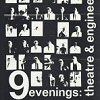from Jeanne Siegel, “An Interview with Hans Haacke” (link)
Clarisse Bardiot’s 9 Evenings: Theatre and Engineering brings together texts and other documents that are the products of a research project that focused on the technological aspects of a festival that took place in New York in 1966 under the same title. The original event brought together 10 artists and some 30 engineers from the Bell Telephone Laboratories in Murray Hill, New Jersey, U.S and the documents C.Bardiot has brought together allows us recall and ‘consider 9 Evenings as one of the very first experiments to apply computer science principles in the context of live performances — even though the technology used was analog. This event was the precursor of today’s “virtual theatres.”‘
| …. 9 Evenings constituted an example of “environmental theatre,” as defined by Michael Kirby, a critic who took part in Rainer’s performance: “It is only when the presentational field and/or performance elements move around, over, or under the spectator that we may call the performance ‘environmental’.” … (read) |  |
An impression from the exhibition the MIT has put together for a touring show on that historic event can be gained from Micah J. Malone’s review at the big RED & Shiny:
| A brief history of the parameters that governed these events goes something like this: The collaborative efforts of ten respected artists from several disciplines (painters, dancers, musicians) got together with some thirty engineers who volunteered their time from Bell Laboratories. | Billy Kluver introducing trailer for 9 Evenings (link) |
| Billy Kluver orchestrated the whole endeavor and chose very accomplished artists whom most know today: Robert Rauschenberg, David Tudor, John Cage, Yvonne Rainer, Steve Paxton, Robert Whitman, Oyvind Fahlstrom, Alex Hay, Deborah Hay, Lucinda Childs. Artists were given ample funding along with access to the most advanced technology (along with people who knew how to make it work) to produce a performance/theatre event within their own artistic sensibilities. Nine long months of arduous work and collaborations resulted in 9 evenings of, well, some very messy performances. As the catalog indicates, many left the performances feeling disappointed, especially the critics who wrote appalling reviews. The many engineering defects, long dead spaces between pieces and sometimes in the middle of them were just a few of the noted problems. Subsequent photos and documentation, as well as efforts to reclaim these events from critical failure (including this exhibition) have resurfaced in recent years. (link) | |
